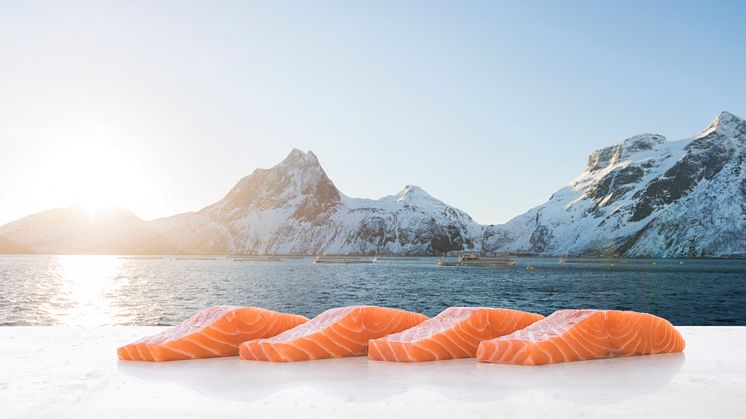
Press release -
Strongest ever July for Norwegian seafood exports
Norway has exported 164,000 tonnes of seafood worth NOK 7.8 billion in July. This is a 6 per cent fall in volume but an 11 per cent, or NOK 768 million, growth in value compared with the same period last year.
So far this year, Norway has exported 1.4 million tonnes of seafood worth NOK 59 billion. Export volume has fallen by 11 per cent, whilst export value has increased by 7 per cent or NOK 3.9 billion compared with the same period last year.
“Growth in the export volume of salmon in July, combined with increased prices, is the main reason why the value of Norwegian seafood exports has remained high during July”.
“Seafood exports fluctuate with the seasons and normally July is our weakest export month. For fishery exports, July 2019 was our second highest July month ever, with an export value of 1.7 billion. This is 5 per cent higher than last year, and just 0.5% less than July 2015, a record year for the fisheries sector”.
“For aquaculture, exports totaled NOK 6.2 billion, which is also a record for the month of July. 78 per cent of total seafood exports in July came from aquaculture”, says Paul T. Aandahl, Seafood Analyst with the Norwegian Seafood Council.
Strong growth for salmon
Norway exported 90,700 tonnes of salmon with a value of NOK 5.8 billion in July. This is a volume increase of 4 percent and a value increase of 11 percent or NOK 584 million compared to July last year.
So far this year, Norway has exported 595,000 tonnes of salmon for NOK 40.3 billion. Volume has increased by 4 per cent, while export value has increased by 7 per cent or NOK 2.5 billion from the same period last year.
The average price for whole fresh salmon in July was NOK 59.55 per kg, compared with NOK 56.38 per kg in July last year. Poland, France and Denmark were the largest markets for salmon in July.
“Demand for salmon continues to increase. The largest growth has been in exports to Asia. This is mainly driven by improved access to the Chinese market. This has led Norwegian exporters to be better able to exploit the potential that exists in this market”, says Paul T. Aandahl, Seafood Analyst at the Norwegian Seafood Council.
Trout exports see large gains
Norway has exported 5,114 tonnes of trout worth NOK 304 million in July. This is a 54 per cent increase in volume and a 45 per cent, or NOK 94 million, growth in value compared to July last year.
So far this year, Norway has exported 29,700 tonnes of trout to a value of NOK 2 billion. This is a 23 per cent growth in volume and a 23 per cent, or NOK 362 million, increase in value compared to the same period in 2018. Belarus and the United States were our biggest trout market in July.
Lower exports of fresh cod, but a good month for frozen cod
Fresh cod
Norway exported 1,400 tonnes of fresh cod, including cod fillet, to a value of NOK 71 million in July. This is a 47 per cent decrease in volume and a 17 per cent, or NOK 14 million, decline in value compared to July last year. Denmark and Sweden were the largest markets for fresh cod in July.
So far this year, Norway has exported 41,100 tonnes of fresh cod, including fillets, worth NOK 1.8 billion. This is a decrease of 23 per cent and a decline of 8 per cent or NOK 160 million from the same period last year.
“According to the Norwegian Fishermen’s Sales Organization, our fishermen have never been better paid for cod than in July 2019. This is also reflected in export prices. The price of fresh whole cod in July this year is 32 per cent (approx. NOK 9.5 per kg) higher than in July last year. Fresh filet has also seen a price rise. The low export volumes of fresh whole cod, in addition to a favorable currency situation, may explain the rise in prices”, says Ingrid K. Pettersen, Seafood Analyst with the Norwegian Seafood Council.
Frozen cod
Norway exported 4,400 tonnes of frozen cod, including fillet, worth NOK 181 million in July. This is a 13 per cent increase in volume and a value increase of 18 per cent, or NOK 28 million, from July last year.
So far this year, Norway has exported 44 600 tonnes of frozen cod, including fillet, for NOK 1.9 billion. This is a volume increase of 4 percent and a value increase of 21 percent or NOK 320 million from the same period last year. China and the UK were the largest markets for frozen cod in July.
Good month for Norwegian clip fish, but reduction for salted fish
Norway exported 5,500 tonnes of whole clipfish for NOK 272 million in July. This is a 5 per cent increase in volume and a value increase of NOK 49 million or 22 per cent compared to July last year.
So far this year, Norway has exported 47,200 tonnes of whole clipfish worth NOK 2.2 billion. This is a decrease of 1 per cent and a value increase of 3 per cent or NOK 68 million from the same period last year. Portugal and Dominican Rep. were the largest clipfish markets in July.
Norway exported 888 tonnes of salted fish for NOK 44 million in July. This is a decrease of 38 per cent and a decline of 30 per cent or NOK 19 million from July last year.
So far this year, Norway has exported 17,600 tonnes of salted fish for NOK 984 million. This is a decrease of 22 per cent, and a decline in value of 12 per cent or NOK 129 million from the same period last year. Portugal and Italy were the largest salt fish markets in July.
“Cod clipfish remains the main contributor to the price growth for clipfish exports, while saithe contributes most to volume growth. In addition, there has been an increase in the price of clipfish of saithe in recent months. A weak Norwegian krone and increased demand are important explanations for this. In addition, the high cod prices have led to a trend towards saithe in several markets”, says Ingrid K. Pettersen.
"So far this year, the increase in export of clipfish made of saithe has been larger than the increase in export of clipfish made of cod. This is partly due to the high prices of cod, and partly because the Norwegian exporters are awaiting clarifications about upcoming changes in the rules regarding salted fish and clipfish made of cod, says Øystein Valanes, with the Norwegian Seafood Council's Trade Mission in Brazil.
Export value sees a small decline for dried fish
Norway exported 238 tonnes of whole stockfish for NOK 29 million in July. This is a 25 per cent reduction in volume, and a decline in value of NOK 700,000 or 2 per cent from the same month last year.
So far this year, Norway has exported 2,000 tonnes of dried fish for NOK 348 million. This is a decrease of 18 per cent but a value increase of NOK 14 million or 4 per cent from the same period last year. Italy and Nigeria were the largest stockfish markets in July.
Increased herring and mackerel exports
Herring
Norway exported 13,700 tonnes of herring for NOK 185 million in July. The volume of herring flaps and herring fillets increased by a total of 172 per cent, while exports of whole herring fell by 45 per cent. Overall, the volume was the same as last year and the value increased by 61 per cent or NOK 70 million compared with July last year.
So far this year, Norway has exported 169,000 tonnes of herring for NOK 1.5 billion. This is a 4 per cent increase in volume and a 10 per cent increase or NOK 144 million from the same period last year.
Mackerel
Norway exported 6,600 tonnes of mackerel for NOK 118 million in July. The volume increase was 41 per cent and the value increased by 74 per cent or NOK 50 million compared with July last year.
So far this year, Norway has exported 88,000 tonnes of mackerel for NOK 1.5 billion. This is a 7 per cent increase in volume, and a value increase of 41 per cent or NOK 434 million from the same period last year. South Korea and China were the largest mackerel markets in July.
Slight reduction in king crab exports
Norway exported 241 tonnes of king crab for NOK 68 million in July. This is a decrease of 6 per cent and a decline in value of NOK 4 million or 6 per cent from July last year.
So far this year, Norway has exported 1,000 tonnes of king crab for NOK 333 million. This is a 16 per cent increase in volume and a 24 per cent increase or NOK 65 million. South Korea and Japan were the most important king crab markets in July.
Enormous rise in snow crab exports
Norway exported 390 tonnes of snow crab to a value of NOK 55 million in July. This is a 236 percent increase in volume and a NOK 39 million or 244 percent value increase compared to July 2018.
So far this year, Norway has exported 1,800 tonnes of king crab for NOK 244 million. This is a 146 per cent increase in volume and a value increase of 151 per cent or NOK 147 million. Denmark and Japan were the most important markets for snow crabs in July.
“There are a number of boats that are now doing well with snow crab fishing. This season has seen a lot of fishing, with a high proportion exported as frozen goods to Asian markets in July. The demand for Norwegian crabs in Asia is high, and the snow crab helps to meet this demand”, says Frank Isaksen, Chief Analyst with the Norwegian Seafood Council.
Stable exports of Norwegian prawns
Norway exported 654 tonnes of prawns for NOK 56 million in July. This is a decrease of 1 per cent in volume, while the value has increased by NOK 5.9 million or 12 per cent.
So far this year, Norway has exported 8 100 tonnes of prawns for NOK 602 million. This is a 55 per cent increase in volume, and a value increase of 42 per cent or NOK 179 million. Sweden and the UK were the most important prawn markets in July.
Disclaimer: The data can contain errors and they can also be subject to later revisions. This can be due to e.g. errors made in the reporting and due to delayed reporting of some data.
Topics
Categories
The Norwegian Seafood Council works with the Norwegian fisheries and aquaculture industries to develop markets for Norwegian seafood through local market intelligence, market development and reputational risk management. The Seafood Council is headquartered in Tromsø and maintains local representatives in twelve of Norway's most important international markets. The Norwegian seafood industry finances the activities of the Norwegian Seafood Council via a tariff on all Norwegian seafood exports.
The Norwegian Seafood Council is a public company owned by the Ministry of Trade, Industry and Fisheries.

